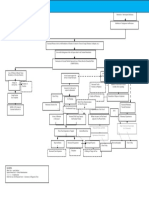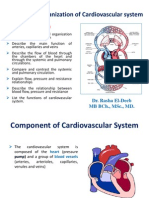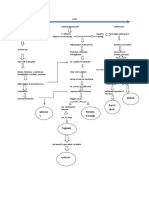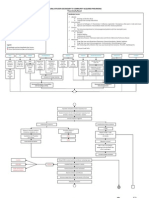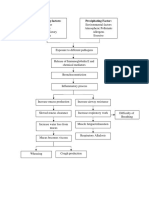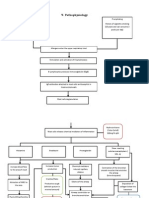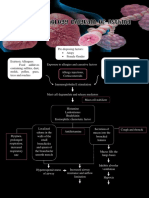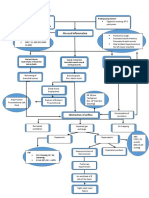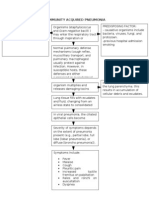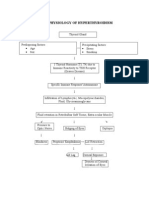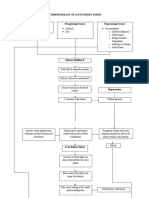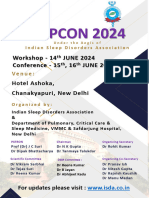100%(2)100% found this document useful (2 votes)
3K viewsCOPD Patho
COPD Patho
Uploaded by
Glenn_Ancheta_2074COPD is caused by inhalation of pathogens like cigarette smoke that trigger an inflammatory response in the lungs. This leads to narrowing of the small airways due to injury and scar tissue formation. Over time, airflow becomes obstructed which causes shortness of breath, coughing, and other symptoms as oxygen levels decrease and carbon dioxide increases in the bloodstream.
Copyright:
Attribution Non-Commercial (BY-NC)
Available Formats
Download as DOC, PDF, TXT or read online from Scribd
COPD Patho
COPD Patho
Uploaded by
Glenn_Ancheta_2074100%(2)100% found this document useful (2 votes)
3K views1 pageCOPD is caused by inhalation of pathogens like cigarette smoke that trigger an inflammatory response in the lungs. This leads to narrowing of the small airways due to injury and scar tissue formation. Over time, airflow becomes obstructed which causes shortness of breath, coughing, and other symptoms as oxygen levels decrease and carbon dioxide increases in the bloodstream.
Original Title
COPD patho
Copyright
© Attribution Non-Commercial (BY-NC)
Available Formats
DOC, PDF, TXT or read online from Scribd
Share this document
Did you find this document useful?
Is this content inappropriate?
COPD is caused by inhalation of pathogens like cigarette smoke that trigger an inflammatory response in the lungs. This leads to narrowing of the small airways due to injury and scar tissue formation. Over time, airflow becomes obstructed which causes shortness of breath, coughing, and other symptoms as oxygen levels decrease and carbon dioxide increases in the bloodstream.
Copyright:
Attribution Non-Commercial (BY-NC)
Available Formats
Download as DOC, PDF, TXT or read online from Scribd
Download as doc, pdf, or txt
100%(2)100% found this document useful (2 votes)
3K views1 pageCOPD Patho
COPD Patho
Uploaded by
Glenn_Ancheta_2074COPD is caused by inhalation of pathogens like cigarette smoke that trigger an inflammatory response in the lungs. This leads to narrowing of the small airways due to injury and scar tissue formation. Over time, airflow becomes obstructed which causes shortness of breath, coughing, and other symptoms as oxygen levels decrease and carbon dioxide increases in the bloodstream.
Copyright:
Attribution Non-Commercial (BY-NC)
Available Formats
Download as DOC, PDF, TXT or read online from Scribd
Download as doc, pdf, or txt
You are on page 1of 1
PATHOPHYSIOLOGY OF COPD
Etiology Predisposing Factors
Streptococcus Pneumonae smoking (110 pack
years)
age
exposure to asbestos
fiber, cotton fibers or
Inhalation of pathogens
Pharynx, nose, larynx and
trachea
(portal of entry)
Inflammatory process
Excess H2O and Injury RBC, fibrin and
plasma protein polymorphonuclear leukocytes
(Lower lobe) infiltrate the alveoli
Narrowing of the small
peripheral airways
Irritates mucus Consolidation of leukocytes and
membrane fibrin
Injury-repair
process Decreased Oxygen
Accumulation of Scar tissue
secretions Decreased tissue perfusion
formation
Narrowing of the
Pale Hypoxemia Tachycardia
airway lumen
Airway Coughing/ DOB Hypoxia
obstruction
Inflammatory
exudates Nasal Tachypnea
Ventilation-
progress flaring
perfusion
inequality
Hyperemia
Hypere
Engorgement of the alveoli
Space with fluids and Pulmonary edema
hemorrhage exudates (Complication)
Chest pain
You might also like
- Final Exam: Emergency First Response Primary CareDocument6 pagesFinal Exam: Emergency First Response Primary CareAlvaro Junior Duran100% (2)
- Scot Irwin, DPT, CCS, and Jan Stephen Tecklin, MS, PT (Eds.) - Cardiopulmonary Physical Therapy. A Guide To Practice (2004)Document473 pagesScot Irwin, DPT, CCS, and Jan Stephen Tecklin, MS, PT (Eds.) - Cardiopulmonary Physical Therapy. A Guide To Practice (2004)Mariuca Mary67% (6)
- Pathophysiology EmphysemaDocument1 pagePathophysiology Emphysemanursing concept mapsNo ratings yet
- Pleurl Effusion Pathophysiology DiagramDocument2 pagesPleurl Effusion Pathophysiology DiagramAkiraMamo75% (4)
- COPD PATHOPHYSIOLOGY DiagramDocument2 pagesCOPD PATHOPHYSIOLOGY Diagramcris_198893% (15)
- Pleural EffusionDocument1 pagePleural Effusionarvinian01100% (2)
- Copd PathDocument2 pagesCopd Pathnursing concept maps100% (4)
- Acute Respiratory Failure Pa Tho PhysiologyDocument4 pagesAcute Respiratory Failure Pa Tho Physiologyroseanne18100% (4)
- Lung Cancer Concept Map-Group 2Document2 pagesLung Cancer Concept Map-Group 2Maria Cristina100% (2)
- PATHOPHYSIOLOGY UrtiDocument2 pagesPATHOPHYSIOLOGY UrtiCris Soland88% (8)
- Pathophysiology Hemorrhagic StrokeDocument1 pagePathophysiology Hemorrhagic StrokeJeffrey Dela CruzNo ratings yet
- Cancer Schematic DiagramDocument1 pageCancer Schematic DiagramCyrus De Asis100% (4)
- Pathophysiology of HCVD DM2 CVD Left Basal GangliaDocument1 pagePathophysiology of HCVD DM2 CVD Left Basal GangliaJake Caballo100% (1)
- Pa Tho Physiology of Hiatal HerniaDocument1 pagePa Tho Physiology of Hiatal HerniaChiskie Faldas Genodia100% (1)
- IX: Pathophysiology: Predisposing Factor Precipitating FactorsDocument2 pagesIX: Pathophysiology: Predisposing Factor Precipitating FactorsCandace AlcarazNo ratings yet
- Functional Organization of Cardiovascular SystemDocument19 pagesFunctional Organization of Cardiovascular SystemIbtesam Mohammed100% (3)
- COPD PathophysiologyDocument1 pageCOPD PathophysiologyJustin Ahorro-Dionisio33% (3)
- Patho of COPD and CorP NewDocument5 pagesPatho of COPD and CorP NewInchan Montesines100% (1)
- Patho PneumoniaDocument2 pagesPatho Pneumoniaailyne_galicia100% (2)
- Pathophysiology Community Aquired Pneumonia and AnemiaDocument3 pagesPathophysiology Community Aquired Pneumonia and Anemiapa3kmedina100% (2)
- COPD PathoDocument1 pageCOPD PathoLeah May AnchetaNo ratings yet
- Copd PathoDocument1 pageCopd PathoRey AngeloNo ratings yet
- Pathophysiology of Chronic Obstructive Pulmonary DisorderDocument2 pagesPathophysiology of Chronic Obstructive Pulmonary DisorderBlessyl Mae EstenzoNo ratings yet
- Pathophysiology of PneumoniaDocument2 pagesPathophysiology of PneumoniaJesselle LasernaNo ratings yet
- Copd PathoDocument2 pagesCopd PathoAlvin RamirezNo ratings yet
- Pathophysiology of PneumoniaDocument2 pagesPathophysiology of PneumoniaMaria Cristina100% (1)
- Pathophysiology of PneumoniaDocument2 pagesPathophysiology of PneumoniaJeffrey Ramos100% (1)
- Non-Modifiable Risk Factors: Modifiable Risk FactorsDocument6 pagesNon-Modifiable Risk Factors: Modifiable Risk FactorsNeil Andro Marcelo100% (1)
- COPD PathophysiologyDocument1 pageCOPD Pathophysiologyaj ajNo ratings yet
- Acute Respiratory FailureDocument2 pagesAcute Respiratory FailurePaolo Luis MontenegroNo ratings yet
- "Acute Coronary Syndrome Non ST Elevation Myocardial Infarction, Hypertensive Cardiovascular Disease, Diabetes Mellitus Type 2, and Community Acquired Pneumonia" Client Centered PathophysiologyDocument3 pages"Acute Coronary Syndrome Non ST Elevation Myocardial Infarction, Hypertensive Cardiovascular Disease, Diabetes Mellitus Type 2, and Community Acquired Pneumonia" Client Centered PathophysiologyCarl Elexer Cuyugan Ano50% (2)
- Pleural Effusion Secondary To Community Acquired Pneumonia PathophysiologyDocument5 pagesPleural Effusion Secondary To Community Acquired Pneumonia PathophysiologyIris Caberte100% (3)
- Pathophysiology Copd-ChfDocument2 pagesPathophysiology Copd-ChfZaira Batalo100% (2)
- Pathophysiology of Congestive Heart FailureDocument3 pagesPathophysiology of Congestive Heart Failuretinayko100% (1)
- Pathophysiology CVDDocument1 pagePathophysiology CVDPamela Shiermaine Filomeno100% (1)
- Acs Nstemi Vs Ua - PathoDocument2 pagesAcs Nstemi Vs Ua - PathoJerom YamatNo ratings yet
- Pathophysiology of Bronchial AsthmaDocument2 pagesPathophysiology of Bronchial AsthmaFirenze Fil100% (21)
- Asthma PathophysiologyDocument1 pageAsthma PathophysiologyElisa Kerr100% (2)
- PP - Community-Acquired PneumoniaDocument1 pagePP - Community-Acquired Pneumonialpetallo100% (2)
- Copd Pathophysiology DiagramDocument2 pagesCopd Pathophysiology DiagramVHyneh Basher100% (1)
- Bronchial Asthma PathophysiologyDocument1 pageBronchial Asthma PathophysiologyElisa Kerr100% (2)
- PathophysiologyDocument4 pagesPathophysiologyCee SanchezNo ratings yet
- Pathophysiology of PneumothoraxDocument1 pagePathophysiology of PneumothoraxDizah Faye OsboroNo ratings yet
- Pathophysiology Diagram of Asthma PDFDocument2 pagesPathophysiology Diagram of Asthma PDFYhenlee Rhizelle MarquezNo ratings yet
- Pathophysiology of COPDDocument42 pagesPathophysiology of COPDRegineCuasSulib100% (3)
- Pathophysiology EmphysemaDocument1 pagePathophysiology EmphysemaGil AswiguiNo ratings yet
- Pathophysiology of AsthmaDocument10 pagesPathophysiology of AsthmaEden Mae100% (4)
- Cap PathophysiologyDocument2 pagesCap PathophysiologyNoriel Henricks Acuna100% (3)
- COPD PathophysioDocument1 pageCOPD Pathophysionanette flores dela cruzNo ratings yet
- Munity Acquired Pneumonia PathoDocument1 pageMunity Acquired Pneumonia PathoJohanna Elaine Tandoc100% (1)
- Concept Map of CellulitisDocument8 pagesConcept Map of CellulitisReese Anne100% (1)
- CAP - Patho DiagramDocument5 pagesCAP - Patho DiagramAzai Rhea Malate63% (8)
- Pathophysiology - HyperthyroidismDocument2 pagesPathophysiology - HyperthyroidismCaren Reyes100% (5)
- Pathophysiology CVD InfarctDocument1 pagePathophysiology CVD InfarctElisa KerrNo ratings yet
- Myocardial Infarction Pathophysiology Schematic DiagramDocument3 pagesMyocardial Infarction Pathophysiology Schematic Diagramnursing concept mapsNo ratings yet
- Pathophysiology of Patent Ductus Arteroisus (PDA)Document2 pagesPathophysiology of Patent Ductus Arteroisus (PDA)Rodel Yacas100% (1)
- Pathognomonic Signs of DiseasesDocument4 pagesPathognomonic Signs of DiseasesAmir Lukman Abdul AzizNo ratings yet
- Pathophysiology of HyperthyroidismDocument8 pagesPathophysiology of Hyperthyroidismaasin100% (1)
- OsteomyelitisDocument1 pageOsteomyelitisJohara Mae De RamaNo ratings yet
- Pathophysiology of Acute Kidney InjuryDocument4 pagesPathophysiology of Acute Kidney InjuryJane Arian Berzabal0% (1)
- Streptococcus Pneumonae: Pathophysiology of CopdDocument1 pageStreptococcus Pneumonae: Pathophysiology of CopdDimpal ChoudharyNo ratings yet
- Pathophysiology PneumoniaDocument2 pagesPathophysiology PneumoniaSheila Mae Escalante67% (3)
- Community Acquired Pneumonia PathophysiologyDocument2 pagesCommunity Acquired Pneumonia PathophysiologybercoaprilgraceNo ratings yet
- Female Gestational Diabetes Mellitus 34 Years Old Diet (High Carbohydrate) Sedentary Lifestyle Obesity StressDocument4 pagesFemale Gestational Diabetes Mellitus 34 Years Old Diet (High Carbohydrate) Sedentary Lifestyle Obesity StressVictoria Castillo TamayoNo ratings yet
- Fisiologia de KatzDocument663 pagesFisiologia de KatzOscar Gascon100% (1)
- Paper 3 Online Biochemistry For July 2021 RevisedDocument2 pagesPaper 3 Online Biochemistry For July 2021 RevisedAbdur Rehman FazalNo ratings yet
- CHAPTER 8 Fundamental of Anatomy, Physiology, Kinesiology in SportsDocument5 pagesCHAPTER 8 Fundamental of Anatomy, Physiology, Kinesiology in SportsShivansh GoelNo ratings yet
- ICU One Pager Vasopressors.1.2Document1 pageICU One Pager Vasopressors.1.2Mohamed MahmoudNo ratings yet
- Efektivitas Terapi Musik Degung Sunda Terhadap Penurunan Tekanan Darah Pada Penderita HipertensiDocument6 pagesEfektivitas Terapi Musik Degung Sunda Terhadap Penurunan Tekanan Darah Pada Penderita HipertensimarselNo ratings yet
- Baroreceptors & Chemoreceptors: ReceptorsDocument4 pagesBaroreceptors & Chemoreceptors: ReceptorsDrbee10No ratings yet
- Informe DEMO Del Holter de Arritmia Contec TLC9803Document14 pagesInforme DEMO Del Holter de Arritmia Contec TLC9803Edward MoralesNo ratings yet
- Jecg D 23 00015Document14 pagesJecg D 23 00015Andres KleinNo ratings yet
- UnconciousnessDocument14 pagesUnconciousnessPradnya JagtapNo ratings yet
- Medicine DamsDocument657 pagesMedicine DamsSubhashNo ratings yet
- ATP-ADP Cycle PowerpointDocument18 pagesATP-ADP Cycle PowerpointJohn Iderf LagardeNo ratings yet
- Sleepcon 2024 Full Program DetailsDocument7 pagesSleepcon 2024 Full Program DetailsRam Pranav SaiNo ratings yet
- 1st QUARTER HeleDocument3 pages1st QUARTER HeleAngelo LeritNo ratings yet
- The Respiratory System: Read The Text Below. Then, Answer The Questions On Pages 2 and 3Document3 pagesThe Respiratory System: Read The Text Below. Then, Answer The Questions On Pages 2 and 3nasirNo ratings yet
- Faradic CurrentDocument30 pagesFaradic CurrentMuqeet7638% (8)
- Sleep and LearningDocument2 pagesSleep and LearningnieotyagiNo ratings yet
- Sheehan's Syndrome PathophysiologyDocument2 pagesSheehan's Syndrome PathophysiologyirismgallNo ratings yet
- Pharmacology of Anaesthetic Agents II: Inhalation Anaesthetic AgentsDocument6 pagesPharmacology of Anaesthetic Agents II: Inhalation Anaesthetic AgentsAna Lucia SaavedraNo ratings yet
- Cardiopulmonary Resuscitation: Dr. Dino Irawan, Span., MMDocument37 pagesCardiopulmonary Resuscitation: Dr. Dino Irawan, Span., MMDiana Fadly MatondangNo ratings yet
- Name: K K ID#: Lab Partner: V S Date: Wednesday 22 Course Code: BIOL 2363 - Metabolism Title of Lab: Assay of Tissue GlycogenDocument7 pagesName: K K ID#: Lab Partner: V S Date: Wednesday 22 Course Code: BIOL 2363 - Metabolism Title of Lab: Assay of Tissue GlycogenKarina KhanNo ratings yet
- Exercise and Cellular Respiration Lab: StandardsDocument5 pagesExercise and Cellular Respiration Lab: Standardsralf gericNo ratings yet
- 22 STRATEGIES TO OPTIMIZE YOUR CIRCADIAN RHYTHM New 0719Document56 pages22 STRATEGIES TO OPTIMIZE YOUR CIRCADIAN RHYTHM New 0719Emilia PerfeitoNo ratings yet
- Techniques of MassageDocument1 pageTechniques of MassageVladGrosuNo ratings yet
- Heart, Blood Vessesls and Blood WorksheetDocument4 pagesHeart, Blood Vessesls and Blood WorksheetJoanne MullengerNo ratings yet
- Homeostasis Lab ActivityDocument2 pagesHomeostasis Lab ActivityMARY GLORY IGNACIONo ratings yet
- Levels of Organization Power Point and Activity PDFDocument8 pagesLevels of Organization Power Point and Activity PDFKaren SinorNo ratings yet


